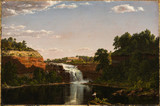Frederic Edwin Church was the preeminent landscape painter and most successful American artist of the mid-nineteenth century. Born into a wealthy and connected Hartford family, Church became the first and only student of the leading painter of the Hudson River School, Thomas Cole (1801–1848) in 1844. Church’s prodigious artistic talent developed rapidly during his two-year apprenticeship, as he created accomplished drawings and paintings of the Hudson River Valley and rural New England.
To better position himself for professional success, Church moved to New York City in 1847. His landscapes, often suffused with religious or historical significance, had broad appeal. Contemporary audiences were particularly impressed by the geologically and topographically accurate details in Church’s depictions of American wilderness and agrarian life. Because of his accomplishments, Church was elected an Associate of the National Academy of Design in 1848. The following year, at the age of twenty-three, he became the youngest Academician in the organization’s history.
In 1853 Church traveled to South America. The dramatic landscapes and waterfalls he encountered there and later painted spurred him to visit the United States’ own Niagara Falls in 1856. Niagara, 1857 (Corcoran Gallery of Art, Washington, D.C.) catapulted Church to fame. A second trip to South America in 1857 resulted in the equally sensational Heart of the Andes, 1859 (Metropolitan Museum of Art, New York), which was bought by a private collector for $10,000, the highest price then ever paid for a painting by a contemporary American artist.
Church married in 1860 and had six children. In 1867, he purchased a hilltop with magnificent views across the Hudson River toward Catskill, N.Y. His extensive travels in the Middle East in 1868–1869 deeply influenced his taste for Persian aesthetics, which are reflected integrally in the design and decoration of Olana, completed on that hilltop in 1872. From 1880 until his death in 1900 (his wife had died in 1899), Church created few major works. He spent nearly every winter in Mexico, returning in the summer to Maine, where he had first painted in 1850, and to Olana, where the sky and sunsets seen from his property inspired his late oil sketches.
BIBLIOGRAPHY
David C. Huntington, The Landscapes of Frederic Edwin Church (New York: G. Braziller, 1966)
David C. Huntington and Richard P. Wunder, Frederic Edwin Church, exh. cat., (Washington, D.C.: Smithsonian Institution, in association with the National Collection of Fine Arts, 1966)
Franklin W. Kelly and Gerald L. Carr, The Early Landscapes of Frederic Edwin Church, 1845-1854 (Forth Worth, Tex.: Amon Carter Museum, 1987)
Franklin W. Kelly, Frederic Church and the National Landscape (Washington, D.C.: Smithsonian Institution Press, 1988)
Franklin W. Kelly et al., Frederic Edwin Church, (Washington, D.C.: National Gallery of Art, 1989)
Gerald L. Carr, Frederic Edwin Church: Catalogue Raisonné of Works of Art at Olana State Historic Site (New York and Cambridge, Eng.: Cambridge University Press, 1994)

